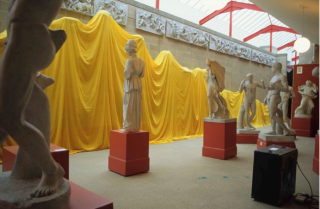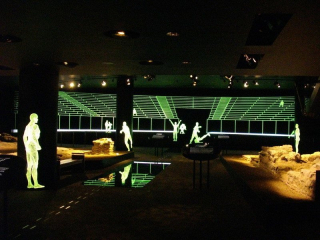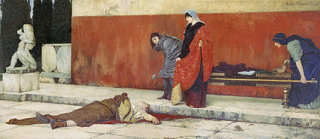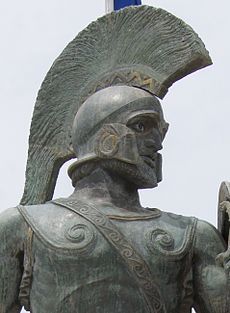Mary Beard's Blog, page 10
September 13, 2016
Norma: look back in irony
If you want one, and only one, reason to defend the on-going study of Classics - I saw it last night. OK, it might seem on the elite side of the equation. But I went to see Bellini's Norma at Covent Garden. It is an opera that is incomprehensibe unless you see the ways it parodies Euripides' Medea. There the scorned wife of Jason, the witch Medea, sends his new partner a deadly poisoned dress as a wedding gift, and kills the children she had with Jason, who himself escapes with his life (while Medea is transported heavenwards).
In Norma, the young Druid activist priestess (Norma) in Gaul under Roman occupation has children by the Roman proconsul (Pollio), who then falls for another Gallic woman and intends to scarper with her to Rome. Sounds familiar? Yes, but in this case the scorned woman does not actually kill the kids (despite a long dalliance with a knife, and last night with a clinical bit of plastic to cope with their bodies); she does not send a deadly dress to the new wife (in fact they are rather bonded); and in the final scene both Jason and Medea (Pollio and Norma) die. Neither escape.
I had some problems with the production last night. The idea that the Druids has been turned into proto-Catholics, with some Nazis thrown in, was awkward for the original Druids v Romans plot (weren't the Romans the Nazis?). And that was especially so when, bizarrely, the friend and confidant of Pollio, Norma/Medea's lover, who was supposed to be a Roman, was dressed as a Christian (aka Druid). Who was on which side here?
I should say that the husband liked the mad mixture and the disruption of certainty; wasnt that the point, he said? Maybe.
I am not so sure. But, apart from the wonderful singing (and it really was), the sense of classical parody was brilliant. There was a brilliant scene in which Norma's children, not in this version about to be killed, bounced around what looked like a suburban flat, complete with sofas, tv, and kids' wheelie toys. Some early critics have wondered what on earth this bit of suburbia is doing in the whole opera. But they have missed the resonant point. This is exactly how the Medea children are regularly played (notably in the NT Helen McCrory production) -- we are being told to think Medea.
Which I did... and I also enjoyed reconnecting with my ex-student at KCL, Alex Beard, no relation, now CEO of the Royal Opera House. We'd be the first to agree that he was pretty feckless back then (I probably was too). But 35 years on, we can admire each other. And it is a telling indication of how, in judging education (anther of my concerns today), we need always to think of long term trajectories rather than short term results. I am proud to have taught ( mmm ?) Alex, and pleased we can now look back in irony.
September 10, 2016
Recasting
I hope people know about the Museum of Classical Archaeology in Cambridge. It is one of the world's best collections of plaster casts of Greek and Roman sculpture. And it's not just a dusty corner (like, I have to confess, it may once have been -- however much loved locally). For decades now it has been hosting modern artists engaging with the classical past. One of my favourites was a 1991 show by the photographer, David Ward, then artist in residence at King's, who covered the (casts of the) Olympia pediments with a large yellow sheet (above) and blew a fan against it: it was called, yes, "Pneuma". And it provoked a frank exchange of views about the point of casts and where exactly they met modern art practice. I am using 'frank exchange of views' in its usual euphemistic sense. There were some then who thought this was playing silly buggers with the classical casts.
A few years later, with one of my best colleagues, I staged a reworking of Euripides' Hippolytus using the casts in the Museum. We tried to get them to act out the play, including the dead Phaedra and Theseus holding the fateful letter. It wasnt quite modern art in the Ward sense, but it did take the plaster casts as modern actors (and play with the word 'cast' of course). It isnt accessible eaily on line but we wrote about it in Arion 1997.
Right now there is an even more ambitious show there, worth taking a look at.
It's called 'Recasting'. And it features a whole lot of engagements between modern artists and the classical past, from Maggi Hambling to Paul Kindersley. It is the brain child of two of our doctoral students, Ruth Allen and James Cahill, who want to make a point about the conversations that are possible between the ancient and the modern world via plaster casts. Here's Maggi Hambling among the heads:
Do go and have a look if you are passing. It's free and fun!
September 7, 2016
There's trolls and trolls
I am quite experienced with trolls. I have faced down some, I have become friends with others, I have failed with yet others, and have generally survived OK (and with some new friends).
It is funny that some of those it is hardest to deal with are on the Amazon site.
I realise that there have been a number of crises over Amazon comments, especially -- in my neck of the woods -- the revelation that one famous historian had been trashing others in the reviews, incognito. I have to say that I have a glimmer of sympathy for the perpetrator here (only a glimmer). I can imagine how someone might come home late at night, well tanked, and have a go at a few others that they (err) disagreed with, online. I'm a generous soul on this: never done it myself, but I have sent emails half a bottle of wine down, that I later regretted. But what I really can't imagine is why, on this generous interpretation, you wouldn't delete the offending comments in the cold light of day. You would look at what you had written and thought a lot better of it; delete before (hopefully) damage done.
For months now, I have been at the receiving end of this on Amazon, and haven't blogged about it because I suspect any responses in Beard's defence would be counter productive. So please dont defend me!
Someone (going under the nom-de-comment of 'Horoscopy', occasionally backed up by 'Paul') has been claiming underneath every favourable Amazon.com review of SPQR that it has been paid for by me. I started out by engaging, offering a discussion, and pointing out that (happily) different people like different books etc. but it made not a blind bit of difference. Amazon.com have been notified of the problem and deleted the allegations (which have occasionally spread to Amazon.co.uk), but they were simply reposted.
OK you might say, just ignore. And I try to. But there are some things that make it difficult. First, there is the baiting ("Mary, you know what we are talking about...." ). But second, and worse, are the charges of corruption against totally innocent commenters who simply say they have enjoyed the book -- and who, I promise, haven't taken a backhander from yours truly.
As I said, please don't go to Amazon to defend me (it will only stir them up), but it is worth thinking about how we get some standards 'below the line' and how we effectively 'police' it. It's not usually a worry on this blog (thanks all), but Tripadvisor is obviously another problem area. I'm not wanting to make a big thing of this. There's no death threats or vile sexism, so live with it... but it is drip drip, damn irritating ... as the trolls know.
September 4, 2016
Why Donald Trump really IS like Julius Caesar
After many months struggling for an ancient parallel for Donald Trump, the American press seems to have latched onto Julius Caesar. Part of the beauty of it is that it works for both sides. It is hard to make the equation with Nero, say, work for supporters and detractors alike (you might want to suspend judgent on Nero, but you have to have tremendous confidence in your own revisionism actually to make him a figure of positive admiration). Caesar does just fine. For the Democrats and unhappy Republicans, he is the man who brought down the democracy and ushered in the autocratic rule of the emperors. For the Trumpites themselves, Caesar is the man who cleared up the mess of the late Republic and ushered in the Pax Romana (aka Americana).
The truth is that most of these comparison are as fragile and misleading as any of the party-game-style comparisons between modern politicians and Romans ('Which Roman is Jeremy Corbyn most like?'... well, none, really). And they generally mangle Roman politics (turning Rome, for example, into a two party state, with a stand-off between optimates and populares), as much as they mangle Trump's aims and agenda.
But most of them (not all, to be fair) miss out the one thing they really do have in common.
Their hair, or lack of it.
As Suetonius makes clear in his biography (chap 45):
"He was rather too picky in the care of hos body, so that he was not only carefully trimmed and shaved, but was plucked too, as some have accused him; in fact, he put up with the disfigurement of his baldness very badly, often suffering the taunts of enemies on that score. And so he used to draw his thinning hair over from the top of his head, and out of all the honours decreed to him by the senate and people there was none other that he accepted or made use of more gladly than the right to wear a laurel wreath at all times."
Or in the Latin (as there are one or two places where you might translate slightly differently): "Circa corporis curam morosior, ut non solum tonderetur diligenter ac raderetur, sed velleretur etiam, ut quidam exprobraverunt, calvitii vero deformitatem iniquissime ferret, saepe obtrectatorum iocis obnoxiam expertus. Ideoque et deficientem capillum revocare a vertice adsueverat et ex omnibus decretis sibi a senatu populoque honoribus non aliud aut recepit aut usurpavit libentius quam ius laureae coronae perpetuo gestandae."
What this means is that in some way Julius Caesar did a Trump-style cover up (though Trump can't exactly use the laurel wreath tactic).
Perhaps he had a liitle more excuse, as baldness was one of the big bogeys for the Roman man and the big topic for snide jokes. "Calvus" (baldie) was one of those border-line insulting Roman "surnames", like "Flaccus" (flabby) or "Naso" (big nose). And one of the best jibes against the emperor Domitian was to call him a "bald Nero". It occasionally stalked women too. A bit of well known banter from the first emperor Augustus (reported in Macrobius' Saturnalia) centred on an encounter with his spirited (to put it favourably) daughter Julia. The emperor was passing her room and spotted her maids pulling out her grey hairs. Some time later, when they had finished, he walked in and -- in apparent innocence -- asked her if she would rather be bald or grey? "Grey, Daddy', she replied. So why are you getting your maids to make to bald then?
But my favourite story about Julius Caesar is also from Suetonius' biography. It is about the songs that his soldiers sang as they walked through the streets to celebrate his Triumph. The tradition was that these songs were on the ribald side, at the expense of the successful general. But in Caesar's case, the squaddies sang words to the effect of "Romans lock up your wives, the bald adulter's back in town.' I don't imagine that the 'adulterer' bit was very painful; but the 'bald' bit must have stung.
How different things were then, eh?
August 31, 2016
The Archers: is it legal?
I realise that I have false memory syndrome when it comes to The Archers. I could have sworn that I heard Grace Archer die after that awful fire. But as I was under one year old at the time, I have to accept that -- while I might have heard it -- I couldn't possibly have remembered it, really. In truth I am one of that substantial proprtion of the adult population of the UK (one in eleven of us apparently claim to listen) who tunes in periodically, and especially for the high points of the story. There was Ruth's illness, Siobhan and Brian's affair, Nigel's fatal fall and now, of course, the abused and pregnant Helen Archer stabbing her husband, the awful Rob Titchener (she's currently awaiting trial on a charge of attempted murder in a custodial Mother and Baby Unit, while looking after the new baby, which she calls Jack, but awful Rob.. just so you know how awful he is (sorry those of this name) .. has dubbed Gideon). It's them above, in case you wondered what they looked like.
The point about The Archers, as every spasmodic listener will tell you, is that you can go from highlight to highlight, leaving a gap of 18 months or so, and you'll still pick up the plot (in the penumbra, the Grundy's will have become a bit more puzzlingly dysfunctional, and you wont quite know who is doing their GCSEs, but the main lines will still be clear enough). But the Helen and Rob thing has kept more of us gripped for longer. A few have no doubt shared some of Allison Pearson's ironic irritaton at it all, while going on listening all the same ("Come on Helen, get a grip... !"). Many more have been putting money into the Helen Titchener (ne�� Archer) Fund for the real life victims of Rob-style abuse. Bcause behind the cosy fiction, there are real crimes and tragedies.
In fact I have been wondering about quite how life-like, in legal terms, the story is.
As every listener knows, all the farming details on The Archers have been vetted (they blazon the name of the agricultural story editor at the end of each episode). But what of the legal story editor? Every lawyer I have come across, including those interviewed on the radio, has been a little bit unwilling to commit to the precise details of what is going on here. And I have a couple of unanswered queries, in particular.
First, Helen's five year old son was a witness to the stabbing, and will be a witness for he prosecution in the up-coming trial. The Archers storyline has him prevented from seeing his Mum in custody for months and months, in case she tries to influence him. Is that authentic? Surely he could see his Mum under supervision, so that she did not influence him. In any case, Rob is busy influencing the little boy all the time. Why isn't someone stopping that?
And could Helen's Mum really walk inadvertently into giving the police a statement which then precluded her too, now as a prosecution witness, from seeing her daughter? Would she not have been warned of the legal consequences?
And, for what it's worth, I don't actually see why the awful Rob should be entirely prevented from seeing his son (in the Mother and Baby Unit). I mean no one disputes that Jack (also known as "Gideon") IS his son. Couldn't he do a supervised visit too, without having to bump into Helen?
Someone reading this might be able to clarify. But if The Archers have got the legal story as right as the agricultural story, then we ought to be taking a careful look at the law, as well as generously donating to the Helen Titchener (ne�� Archer) Fund.
August 26, 2016
The Chester Amphitheatre
There are plans afoot I hear for the Chester Roman amphitheatre. That is to say that the listed house (Dee House) that you can see in the background to the picture above, and which covers one side of what would have been the amphitheatre, is now the subject of an application to "redevelop". It raise all kinds of issues about how best to incorporate the ancient heritage into the modern city-scape.
It goes without saying that if there is any new building, it should be properly investigated with the trowel first. But what then? One idea is that it should become a heritage site, and we should let people see the other side of the amphitheatre, which has always been covered (and there is a petition more or less to this effect here). My heart is with them, but my head wonders a bit about how much heritage sites (as simple sites) can be a popular and lucrative focus of local tourism in themselves.
I think that it is interesting, at least, that the Richard III Visitor Centre in Leicester has not made its visitor targets. They were aiming at 100,000 people a year and have managed 80,000. That is maybe a victory. It has certainly brought a load of visitors, and money into Leicester, even if it hasn't met the target. But how much longevity it has in the long term remains to be seen. I still predict that in 15 years the visitor centre will be up for the highest bidder. But I would be very happy to be proved wrong,
I would like to think that there are different alternatives -- that the Roman or other heritage can be preserved in a variety of different ways, which gives open access but doesn't simply create a ruin (though I do love ruins). I am not sure that, much as I have come to terms with the reconstruction/preservation of the London amphitheatre under the Guildhall (above), that it is the model for the future. I suspect that the London amphtheatre is largely used for corporate events in the city. But it does give a version of how you might think wider about what a heritage site might be. I stayed in a reasonably cheap hotel in Sofia which had the Roman amphitheatre built into its basement and spa...
Could we have half the Chester amphitheatre preserved in a nice, open access bar... or...
I should say that I feel quite bonded to Chester. It was my shopping destination of choice when I was a young teenager and I was occasionally taken to the retail heaven of Chester by my mum. And my great friend Graham Webster, a wonderful Romano-British archaeologist, was once the curator at the Grosvenor Museum there. When you look back at your career and at who helped you, for me Graham stands out. I first learned about archaeology from him and he gave me more responsibility on an excavation than I had in a way earned -- and he taught me to think about what archaeological evidence might mean, and in many ways he taught me to grow up.
Thank you!
August 22, 2016
The bloody history behind the EU summit
The mini-summit between Mr Hollande, Mrs Merkel and Mr Renzi has been taking place on the island of Ventotene off the Italian coast. It is, we have been reminded, a symbolic place. For it was in a prison here that during World War II a pair of Italians, Ernesto Rossi and Altiero Spinelli, wrote the "Ventotene Manifesto", laying out a plan for a federal Europe -- one of the inspirations of the EU. Apparently the trio of leaders are due to lay a wreath on Spinelli's grave, while they are there.
There are rather different associations of the place for any classicist. For Ventotene was ancient Pandateria/Pandataria, and a convenient place of confinement centuries before Mussolini, or the Bourbons, banged people up there. It was, in fact, where Roman emperors sent their inconvenient, treacherous, badly behaved or just plain unlucky women folk. They didn't need too many "facilities". The island is about two miles by half a mile in all, and a fairly inhospitably rocky. All the emperor needed to do was make sure that the "prisoner" didn't hitch a ride on a passing boat. At 30 miles from the coast of the mainland, swimming wasn't an option.
It was probably the first emperor Augustus who started the custom, when he banished his daughter Julia there in 2 BC, for the usual combination of adultery and treason.
On the plus side she had her mother for company, on the minus side she was forbidden any alcohol (the loaded implication being that abstinence would have been a considerable punishment for this particular princess). And she was only there for five years (only...?), before her father relented and let her back as far as Rhegium, though never to Rome itself. She managed to outive him, but died in mysterious circumstances only a few months after him. The finger of suspicion, of course, pointed at the new emperor, Tiberius.
The next prisoner had it a lot worse, Julia's daughter, Agrippina the Elder. She fell foul of Tiberius and ended up on Pandateria in 29 AD, where she was flogged, blinded in one eye and starved herself to death a few years later. She was probably followed by her daughter, another Julia. The evidence isnt quite so cut and dried in this case (it could possibly have been a different island), but she was certainly exiled once by her brother Caligula, then again by his successor and her uncle, Claudius -- who seems to have made sure she starved herself to death in the early 40s. By all accounts the most innocent of the lot was Nero's first wife Octavia, who was sent there on a charge of adultery, but really (it's usually supposed) to get her out of the way of his new partnership with Poppaea. A death sentence followed in 62 and her head was sent back from the island to Rome, for the delectation of the emperor and his new wife (that's a version of the scene by Giovanni Muzzioli above). And it didnt stop there. Vespasian's granddaughter was packed off to Pandateria by her uncle Domitian -- it is sometimes fancifully suggested that the charge was Christianity.
So all in all a grisly place, whose inheritance isnt just to be found in the seeds of a united Europe. I hope Mrs Merkel, in particular, spares a moment to think of its female victims.
August 20, 2016
Hockey sticks
I confess that I have had taken a little more pleasure in the Olympics than I predicted -- although I still admire the achievements more than I want actually to watch them. But I have become more interested, once again, in the background of these elite athetes. Who are they? Where do they come from -- and how?
I decided to have a look, not entirely at random, at the Olympic squad of 19, including reserves, that gave us our gold medal winning women's hockey team. Let me underline that I am not knocking these young women who have trained and practised beyond what most people could contemplate and -- as a quick google will turn up -- have obviously done a load of outreach events at schools and clubs, spreading the word about sport. Hats off to them.
But their background (again I am relying on google here) is not exactly ordinary. Out of the 19, I reckon that 10 went to independent school (and 3 to one independent school alone, that is Repton). 11 read Sports Sciences at university. Only one (a woman of Asian origin who, for what it's worth, went to an independent school) seems anything other than white British. Several have a family background in sport. The excellent captain is not only married to another team member, but her mother is a sports academic, her sister a professional hockey player in Holland, married to a Dutch male hockey international.
I dont know exactly what I feel about this. I can see only too well that people in the same field get together and breed more like themselves: doctors marry doctors; I am married to an academic, and both my children have done (or are doing) PhDs. And I am not sure what I think about what we should do about the class bias in sport. Hockey I guess lies somewhere in the middle, between boxing and dressage (which you can hardly get into early unless Mum and Dad can buy you a pony). Maybe it would be a good idea if a wider range of people took up sticks. But I'm not sure that I want polo players doing outreach to their local primary schools -- or for that matter the upper middle class taking over boxing. To put it another way, I think that the micro cultures of sport are more complicated than they look.
But I do feel irritated at the double standard that operates between elite sport and elite education. I have no doubt that we all in this country have a lot more to do to make educational opportunities fairer (in terms of class, wealth, ethnicity etc etc ). But elite universities get an awful lot more stick than elite sports when it comes to access. The record of my own university on access and diversity is rather better (and we are trying even harder) than that of the UK womens' hockey squad and we win just as many prizes and medals.
It's odd that we get lambasted for lack of diversity when they dont.
August 18, 2016
Taking Suetonius seriously
When I was a student, and a lot later to be honest, I was taught to be a bit sniffy about Suetonius, biographer of the Twelve Caesars. This was the gossip of the Roman empire. Suetonius may have had good access to the stories of the imperial court behind the scenes (he had worked in the proto-civil service in the Roman palace, and so had privileged access to the imperial filing cabinets, and quoted a few choice documents in his biographies). But he was a 'biographer' rather than a 'historian', and so a lot lower down the intellectual pecking order. And we looked askance at the stories of what Tiberius got up to in his swimming pool (little boys nibbling his genitals, according to Suetonius), or Caligula's plans (only plans, remember) to make his horse a consul.
It took me a good few decades to see that there was a lot more in Suetonius. And that came when I decided to read not just individual lives amongst the Twelve (according to which emperor happened to interest me at the time), but to read the Twelve Ceasrs, sequentially, cover to cover -- as I imagine they were originally intended to be read. When you do that, you see that Suetonius offers more than you might have thought. He isn't giving you just twelve individual biographies, but a story of dynastic succession and the transmission of power.
Hence all the stuff that Renaissance artists were smarter at picking up than we are about omens of rise to the throne, about the complexities of the transmission of power. It may be that we have got preoccupied by the anecdotes of transgression, but that's partly because we have skipped over all those portents and omens about imperial succession (the eagle landing on Claudius' shoulder, the dead man's hand presented to Vespasian, and so on).
But there are also some individual passages of Suetonius which hit home much harder than we often acknowledge.
My review of the Nero exhibitions in Trier is in the TLS this week (subscribers only ... go on it's worth it). And I am hugely pleased that it is illustrated by the late nineteenth-century painting by Vasily Smirnov, on show in Trier and at the top of this post. It wonderfully evokes Suetonius' description of the last hours of Nero's reign. There is rebellion on the frontiers and support for Nero is fading. How did the emperor know? Well, according to the biography, he was abandoned in the palace itself, his servants no longer listened to him, and the emptiness of his power was revealed within what had been its heart:
"Having therefore put off further consideration to the following day, he awoke about midnight and finding that the guard of soldiers had left, he sprang from his bed and sent for all his friends. Since no reply came back from anyone, he went himself to their rooms with a few followers. But finding that all the doors were closed and that no one replied to him, he returned to his own chamber . . ."
It's a deceptivel simple passage, as smart as many penned by Tacitus in capturing what the loss of the throne actually means.
Smirnov picks that up, with his dead emperor lying alone on the floor, and about to be taken out for burial by a handful of faithful women (again echoing Suetonius). But neatly he adds a famous ancient sculpture at the left hand side, a small boy playing with/strangling a goose. It isn't the most tasteful of ancient works of art, but it is a pointed comment on Nero and his reign. How good a symbol for the reign of teen-aged emperor Nero was that image of a toddler grappling (murderously?) with a pet bird?
August 14, 2016
What's in a name?
Pity the poor picture editor. This weekend in the Sunday Times there was a short "Olympic trivia feature" -- including reference to the famous ancient athlete, Leonidas of Rhodes, who won three running titles at four successive Olympic Games in the second century BC. Nice to give him his due, but the only trouble was that the piece was illustrated by a picture of his namesake Leonidas King of Sparta, who had lived 300 years earlier and died "heroically" (and pointlessly) at the Battle of Thermopylae.
It is true that I had a pedant moment, and a sense of annoyance that somehow getting such things right doesn't seem to matter very much, when you are talking 2000 years ago. I mean they are all Greek, aren't they? Who cares which Leonidas, or even that there were more than one.
But the truth is that all kinds of people have trouble with Greek and Roman names.
Classicists themselves are a bit to ready to assume that the same names are likely to refer to the same person. Sometimes that is a fair bet. I like to think that the Syrian "Barates" from Palmyra who put up a tombstone to his wife Regina near Hadrian's Wall was the same as the "Ba]rathes Palmyrenus" whose own tombstone has been discovered at nearby Corbridge (although we have to admit that Barates is a fairly common Syrian name and the spelling is slightly different different, and the "Ba" is missing in the second inscription anyway).
But all too often we are asked to believe that a "Jucundus" here is the same as a "Jucundus" a hundred miles away (and maybe a hundred years as well).Never mind the fact that there were any number of Romans with that name. It is a bit like assuming that I am the same as, or related to, the "other" Mary Beard.
But there is a particularly intriguing variant on this in the highest echelons of the Roman imperial court. In original Roman nomenclature, there is an awful lot of overlap between one imperial prince or princess and the others. This could be manipulated to make a point. One of the original names of the emperor Tiberius was "Nero" and at one point Tacitus actually calls him that -- presumably to suggested a close resemblance with the emperor more usually known as Nero.
It is even more striking with the women, half of whom turn out to be called Agrippina (not just the two we now tend to know as Agrippina the "elder" and the "younger"). Rober Graves in I, Claudius tried to help the innocent reader by calling them things like "Agripinilla". And even the Romans would sometimes use different names entirely for the sake of clarity. And that's where a little puzzle I've mentioned before comes in.
The Rubens painting above (in the National Gallery in Washington DC) was traditionally known as "Tiberius and Agrippina", but art historians began to worry that such a title was really very odd. Tiberius had, after all, had Agrippina (the elder) put to death. It was hard to imagine that that pair would have been shown in tandem like this. So it became regularly re-titled as "Germanicus and Agrippina" (Germanicus being Agrippina the elder's husband).
What those who were worried had forgotten was that Tiberius' much loved first wife, whom we regularly call "Vipsania", was also called "Agrippina". No need for retitling at all, then.
It's not only hard pressed picture editors who get their Leonidas's or Agrippinas in a twist.
Mary Beard's Blog
- Mary Beard's profile
- 4106 followers


















